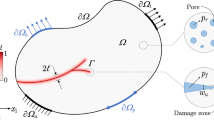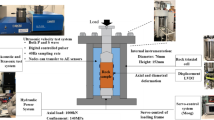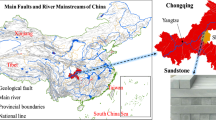Abstract
Overhanging rock instability is a serious geological problem in mountainous regions. The initiation and propagation of a controlling crack are the fundamental causes of overhanging rock failure. In the view of fracture mechanics, the instability of toppling overhanging rock can be equivalent to the effect of pure shear and pure bending moment. This paper analyzes the evolution of displacement–load curves and failure modes of overhanging rock models at different crack lengths, crack angles, and load distances based on fracture tests of the toppling overhanging rock model. Maximum circumferential stress theory is used as the fracture criterion of mixed mode I–II fractures to calculate the stress intensity factor (SIF) of the crack tip and the theoretical failure load of the overhanging rock model. The fracture mode mechanism is analyzed by the calculated SIF. We use the extended finite element method to simulate the crack propagation path and analyze the change process from equivalent stresses of the numerical model using propagation steps. Comparisons between the physical tests, theoretical calculations, and numerical simulations verify the rationality of the experimental results.















Similar content being viewed by others
Abbreviations
- T :
-
External vertical load on the overhanging rock
- G :
-
Weight of the overhanging rock
- a 0 :
-
Length of the controlling crack
- b :
-
Locking section length of the overhanging rock
- H :
-
Thickness of the overhanging rock slab
- β :
-
Inclination angle of the controlling crack
- x 1, x 2 :
-
Horizontal distances from the load to the controlling crack
- K IC :
-
Fracture toughness
- σ rr, σ θθ, τ rθ :
-
Radial stress, circumferential tensile stress, and shear stress at the crack tip
- θ :
-
Crack deviation angle (positive counterclockwise, negative clockwise)
- r :
-
Distance from the crack tip
- SIF:
-
Stress intensity factor
- K I, K II :
-
Mode I and II stress intensity factors
- a :
-
Half-length of the crack
- σ ∞, τ ∞ :
-
Far-field tensile stress and far-field shear stress
- K e :
-
Equivalent stress intensity factor
- t :
-
Thickness of the model
- F :
-
Boundary correction factor
References
Anderson TL (2005) Fracture mechanics: fundamentals and applications. CRC Taylor &Francis, New York
Areias PMA, Belytschko T (2005) Non-linear analysis of shells with arbitrary evolving cracks using XFEM. Int J Numer Methods Eng 65(3):384–415
Atkinson BK (1987) Fracture mechanics of rock. Academic Press, New York
Belytschko T, Black T (1999) Elastic crack growth in finite elements with minimal remeshing. Int J Numer Methods Eng 45(5):601–620
Belytschko T, Lu YY, Gu L (1995) Crack propagation by element-free Galerkin methods. Eng Fract Mech 51(2):295–315
Bouchard PO, Bay F, Chastel Y, Tovena I (2000) Crack propagation modelling using an advanced remeshing technique. Comput Methods Appl Mech Eng 189:723–742
Braathen A, Blikra LH, Berg SS, Karlsen F (2004) Rock slope failures of Norway: type, geometry, deformation mechanisms and stability. Norw J Geol 84(5):67–88
Chen HK, Tang HM (2007) Method to calculate fatigue fracture life of control fissure in perilous rock. Appl Math Mech Engl 28:643–649
Chen HK, Tang HM (2013) Study on the support—anchor combined technique to control perilous rock at the source of avalanche by fracture mechanics. Int Appl Mech 49(3):135–144
Chen HK, Tang HM, Ye SQ (2006) Damage model of control fissure in perilous rock. Appl Math Mech Engl 27(7):967–974
Chessa J, Smolinski P, Belytschko T (2002) The extended finite element method (XFEM) for solidification problems. Int J Numer Methods Eng 53(8):1959–1977
Erdogan F, Sih GC (1963) On the crack extension in plates under plane loading and transverse shear. J Basic Eng 85:519–527
Ergenzinger C, Seifried R, Eberhard P (2011) A discrete element model to describe failure of strong rock in uniaxial compression. Granul Matter 13(4):341–364
Huang RQ, Wu LZ, He Q, Li JH (2017) Stress intensity factor analysis and the stability of overhanging rock. Rock Mech Rock Eng 50(8):2135–2142
ISRM Testing Commission (co-ordinator: Fowell RJ) (1995) Suggested method for determining mode I fracture toughness using cracked chevron notched Brazilian disc (CCNBD) specimens. Int J Rock Mech Min Sci Geomech Abstr 32:57–64
Kemeny J (2003) The time-dependent reduction of sliding cohesion due to rock bridges along discontinuities: a fracture mechanics approach. Rock Mech Rock Eng 36(1):27–38
Kemeny J (2005) Time-dependent drift degradation due to the progressive failure of rock bridges along discontinuities. Int J Rock Mech Min 42(1):35–46
Lawn B, Wilshaw R (1975) Indentation fracture: principles and applications. J Mater Sci 10(6):1049–1081
Lecampion B (2009) An extended finite element method for hydraulic fracture problems. Commun Numer Methods Eng 25(2):121–133
Murakami Y (1987) Stress intensity factors handbook. Pergamon Press, Oxford
Pathak H, Singh A, Singh IV (2013) Fatigue crack growth simulations of 3-D problems using XFEM. Int J Mech Sci 76(11):112–131
Rice JR, Rosengren GF (1968) Plane strain deformation near a crack tip in a power-law hardening material. J Mech Phys Solids 16(1):1–12
Tharp TM, Coffin DF (1985) Field application of fracture mechanics analysis to small rock slopes. Proceedings of 26th US symposium on rock mechanics, South Dakota School of Mines and Technology, Rapid City, 26–28 June 1985
Wu LZ, Li B, Huang RQ, Wang QZ (2016) Study on Mode I–II hybrid fracture criteria for the stability analysis of sliding overhanging rock. Eng Geol 209:187–195
Zhang G, Zhao Y, Peng X (2010) Simulation of toppling failure of rock slope by numerical manifold method. Int J Comp Methods 7(1):167–189
Acknowledgements
We thank the Funds for Creative Research Groups of China (no. 41521002) and the National Natural Science Foundation of China (no. 41672282), and State Key Laboratory of Geohazard Prevention and Geoenvironment Prevention Independent Research Project (SKLGP2017Z003) for supporting this project. The first author thanks the Innovative Team of Chengdu University of Technology.
Author information
Authors and Affiliations
Corresponding author
Ethics declarations
Conflict of interest
The authors declare that they have no conflict of interest.
Additional information
Publisher’s Note
Springer Nature remains neutral with regard to jurisdictional claims in published maps and institutional affiliations.
Rights and permissions
About this article
Cite this article
Wu, L.Z., Shao, G.Q., Huang, R.Q. et al. Overhanging Rock: Theoretical, Physical and Numerical Modeling. Rock Mech Rock Eng 51, 3585–3597 (2018). https://doi.org/10.1007/s00603-018-1543-9
Received:
Accepted:
Published:
Issue Date:
DOI: https://doi.org/10.1007/s00603-018-1543-9




